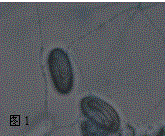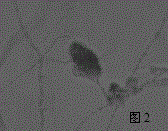Parasitism effect of trichoderma T11-W on root-knot nematode egg and application of trichoderma T11-W
A technology of root-knot nematode and southern root-knot nematode, applied in application, nematicide, biocide and other directions, can solve problems such as unreported parasitic effect of vegetable root-knot nematode eggs
- Summary
- Abstract
- Description
- Claims
- Application Information
AI Technical Summary
Problems solved by technology
Method used
Image
Examples
Embodiment 1
[0035] Example 1 Isolation and identification of root-knot nematode ova parasite
[0036] 1. The isolation steps of strain T11-W are as follows:
[0037] (1) Collection of samples: Cucumber root-knot nematodes were collected at Liying Village, Daddy Town, Shouguang. The root system with root-knot nematodes was dug out with a shovel, placed in a kraft paper envelope, and brought back to the laboratory.
[0038] (2) Separation method:
[0039] The collected cucumber root-knot nematode (identified as root-knot nematode incognita Meloidogyne incognita ) diseased root, after washing the root topsoil, cut the root with a large number of root knots, cut it into 1cm root segment, and put it into a 1000ml beaker. Add 500ml of 1% NaClO solution to the beaker, cover and stir for 2 minutes, pour the root fragments together with the solution into the 75 μm and 26 μm sieves, rinse the root fragments on the 75 μm mesh sieve with tap water, so that the root fragments on the 26 μm sieve are...
Embodiment 2
[0045] Example 2 Study on Parasitism of Tomato Meloidogyne Eggs by T11-W
[0046] 1 Preparation of Trichoderma spore suspension
[0047] Trichoderma strains T11-w and LTR-2 were respectively inoculated on PDA medium, cultured at 25°C until conidia were produced, washed with sterile water, and filtered through 5 layers of sterile gauze. Count the spore concentration of the suspension under a microscope with a hemocytometer and dilute it to a target concentration of 7 x 10 7 cfu / mL, spare.
[0048] Preparation of 2 root knot nematode egg suspensions
[0049] Take the tomato root system with severe disease, rinse it with tap water, cut it into 1cm root segments, and put it into a 1000ml beaker. Add 500ml of 1% NaClO solution to the beaker, cover and stir for 2 minutes, pour the root fragments together with the solution into the 75 μm and 26 μm sieves, rinse the root fragments on the 75 μm mesh sieve with tap water, so that the root fragments on the 26 μm sieve are as close as...
Embodiment 3
[0058] The cultivation of embodiment 3 Trichoderma T11-W conidia
[0059] The cultivation of Trichoderma T11-W conidia is carried out in the following steps:
[0060] (1) Incline strains: use solid PDA medium to inoculate Trichoderma T11-W on test tube medium, and culture at 28°C for 2-3 days.
[0061] (2) Eggplant bottle strains: Use liquid PDA medium to inoculate the test tube strains in liquid eggplant bottles, and place them on a shaker at 28°C for shaking culture for 3-4 days.
[0062] (3) Solid inoculation:
[0063] (3.1) Preparation of solid medium: Mix bran and rice husk evenly at a volume ratio of 4:1, then add 50%-60% water, sterilize at 121°C for 40 minutes, and set aside.
[0064] (3.2) Inoculation: Use a mixing inoculator to mix the liquid strain and the solid medium evenly, the inoculum amount is 5-10%, and transfer it to the solid culture room for cultivation after inoculation.
[0065] (4) Cultivation: The thickness of the medium is 5cm, the material tempera...
PUM
 Login to View More
Login to View More Abstract
Description
Claims
Application Information
 Login to View More
Login to View More - R&D
- Intellectual Property
- Life Sciences
- Materials
- Tech Scout
- Unparalleled Data Quality
- Higher Quality Content
- 60% Fewer Hallucinations
Browse by: Latest US Patents, China's latest patents, Technical Efficacy Thesaurus, Application Domain, Technology Topic, Popular Technical Reports.
© 2025 PatSnap. All rights reserved.Legal|Privacy policy|Modern Slavery Act Transparency Statement|Sitemap|About US| Contact US: help@patsnap.com



